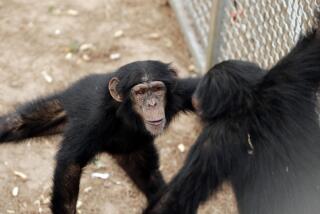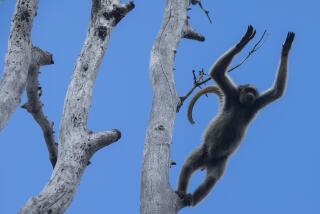Researchers Are Going Ape Over Mystery Primate
- Share via
OMAHA, Neb. — Scientists hope DNA analysis will reveal the origins of large apes discovered in the heart of Africa by an Atlanta primatologist.
Genetics research has begun at Omaha’s Henry Doorly Zoo on fecal samples collected this summer from the rare apes to determine if they make up a new species, a new subspecies or a hybrid -- possibly a mix between a chimpanzee and gorilla.
“It’s a new mystery ape and we are doing the DNA fingerprinting to find out more,” said zoo director Lee Simmons.
The apes, which stand 5 to 6 feet tall and have feet nearly 14 inches long, were documented last year by primatologist Shelly Williams in a forest in the northern part of the Democratic Republic of Congo. They have bodies similar to gorillas, but generally the facial characteristics of a chimpanzee. She said the animals sleep on the ground at night like gorillas, but eat a fruit-rich diet like chimpanzees.
“I can’t speculate yet as to what they are. Their behavior is so unusual. It’s a puzzle.... I feel like Dr. Doolittle in the land of Oz,” said Williams, who has captured video of the animals.
Because of their size and elusiveness, the apes have no predators -- not even poachers hunt them, Williams said. With no fear of lions, leopards or hyenas, they animals hoot at the moon, which is extremely unusual for apes, she said.
“The people are very afraid of them. They call them the ‘lion killers’ because they are huge creatures,” Williams said. “The folklore is they could kill lions.”
Williams collected fecal samples from the animals’ nests before returning in June from her most recent trip to the Congo. In August, she delivered those samples to the Omaha zoo, where they are being compared with the DNA of captive gorillas, bonobos (pygmy chimps) and chimps, said Ed Louis, a conservation geneticist leading the research in Omaha.
“If this ends up being a new species of ape, that would be amazing. Even if it’s a hybridization, that would be fascinating,” Louis said. “However, at this point, we don’t even know what we’re dealing with.”
It is possible for a chimpanzee and a gorilla to have viable, fertile offspring, Williams said.
The DNA analysis is expected to take months. But it may be impossible to determine the apes’ ancestry without getting a sample of blood or tissue.
Louis plans to join Williams on her next trip to the Congo, likely in November, to collect more specimens for analysis.
“Without getting your hands on the animal, it’s difficult to say what it is,” said Louis, who has identified several new species of monkey-like lemurs in Madagascar through his genetic research.
Williams collected hair from the apes’ nests, but none included follicles, needed for extracting cells for DNA research. She also made molds of footprints near the nests. The footprints were nearly two inches larger than the average gorilla’s foot, about 12 inches long.
What makes the gorilla-like apes more unusual is that the closest gorillas documented in that part of Africa are thousands of miles away, Williams said.
“The possibility is there that this is a new species due to isolation,” she said.
The last discovery of a great ape was in 1902 when mountain gorillas were found in the Virunga Volcanoes, where the borders of the Congo, Rwanda and Uganda meet.
Russell Mittermeier, president of Conservation International, a Washington-based organization that focuses on biodiversity conservation, is not ruling out the possibility that the apes Williams is studying make up a new species. “If this turns out to be a new species of ape, it would be one of the big discoveries of primatology,” he said. “It has been so long since there has been a distinct discovery.”
More to Read
Sign up for Essential California
The most important California stories and recommendations in your inbox every morning.
You may occasionally receive promotional content from the Los Angeles Times.













